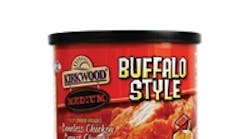Chicago-based Koch Foods, a private labeler, has developed a new interactive “spin” packaging for Aldi supermarkets. The package is being used to introduce a new line of frozen chicken breast chunks under Aldi’s Kirkwood brand. In recent weeks, four Kirkwood recipes from Koch—Asian Style Zyng, Buffalo (medium and spicy), and Garlic Parmesan—have arrived in freezer cases at more than 1,100 Aldi outlets nationwide.
The new Koch Foods package, partnering with Huhtamaki Inc., incorporates an OPP (oriented polypropylene) label, supplied by MPI Label Systems, that is placed over a specially designed round-shaped paperboard Huhtamaki Ultrakan container. Inside are breaded chicken breast chunks and a bag with ingredients for each variety’s special enrobing sauce. The label carries product photos plus nutrition facts, bar codes and other standard required product data, along with a clear section that reveals additional information on the Huhtamaki-printed base container when consumers “spin” the outer label.
The resulting combination provides Aldi with approximately 75% more label surface for communicating with shoppers. Currently, the “peek-a-boo” panels convey recipe suggestions, sauce-and-serve preparation instructions, and cross-sell a variety of other Kirkwood brand products.
Koch Foods also has an exclusivity arrangement with Spinformation Company. Even though the “spin label” package concept is new to the food market, Spinformation’s package designs have been previously used by several beverage companies and over-the-counter pharmaceutical products.
“Real estate on packaging is at a premium, especially in a category like ours where there are so many regulatory requirements,” says David Mehlman, Koch Foods’ director of retail marketing. “Now we can provide the required nutritional and other data plus product photos on the outer spin label—and also have room to give shoppers serving suggestions, illustrated preparation instructions and new product ideas on the base container ‘peek-a-boo’ panels. It’s a chance to connect in ways you otherwise wouldn’t have.”
In addition to the extra space for information, Mehlman says the package offers two major advantages from a marketing and retailing standpoint.
“First, it lets you maximize the number of facings you have in a traditional grocery store.” Noting that the new Kirkwood brand products are currently found in freezer bunkers at Aldi, Mehlman indicated the package merchandises really well in an upright freezer. “On a 30-inch shelf, you’re able to get significantly more facings, a big factor in a category with three or four brands versus competitors in gusset bags. In terms of retail space management, it’s a major plus.
“This also helps highlight our new product offerings as shoppers walk the aisles. People in grocery stores typically focus on getting in and out quickly with the usual items on their list. The new package gives our products a way to stand out from the rest, and to open shoppers’ eyes and minds to trialing something else.”
Adapting the “spin” concept for frozen foods definitely was a team effort—internally at Koch Foods as well as among Koch, Aldi and Koch’s supplier-partners: Huhtamaki, MPI Label Systems and labeling equipment manufacturer Accraply Trine.
Judy Rogers, Huhtamaki’s new business development manager, explains that Huhtamaki made modifications to its paperboard container sidewalls in order to make the spin label work properly. Huhtamaki also worked closely with Accraply Trine on the label application, to ensure proper tightness around the carton as well as direction for the spin.
Likewise, Huhtamaki worked in close collaboration with MPI so that the label would spin freely on the container. MPI incorporated developments into the label material to avoid wrinkling and provides for use of special inks in order achieve opacity over most of its area, except for the clear “peek-a-boo” window that allows consumers to view selected sections printed on the base container.
The container is formed in-house by Koch Foods using a Huhtamaki forming machine. Preprinted and die-cut package sidewalls from Huhtamaki are shipped flat, a method that delivers 10 times as much packaging per truckload compared to “shipping air” in preformed containers. This helps reduces transportation costs, which will give support to the growing concerns of rising fuel prices, as well as on-site warehousing requirements, all contributing to making a much smaller carbon footprint.
On-demand, in-plant package forming also gives Koch Foods flexibility to change packaging virtually on-the-fly for new Kirkwood recipes, or to switch “peek-a-boo” panel sections for seasonal or other promotions. The entire package—container and spin label—is said to cost no more than traditional plastic bags.



